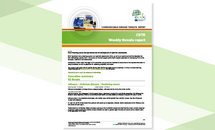Communicable disease threats report 30 June-6 July 2013, week 27
The ECDC communicable disease threats report is a weekly bulletin intended for epidemiologists and health professionals in the area of communicable disease prevention and control. Summarising information gathered by ECDC through its epidemic intelligence activities regarding communicable disease threats of concern to the European Union, it also provides updates on the global situation and changes in the epidemiology of communicable diseases with potential to affect Europe, including diseases that are the focus of eradication efforts.
Executive Summary
Clusters of invasive meningococcal disease (IMD) have been reported among men who have sex with men in France (3 cases in Paris) and Germany (3 cases in Berlin) since February 2013. An additional case was identified retrospectively in Belgium, also caused by Neisseria meningitidis serogroup C.
Initial typing results suggest that the cases are due to a strain which is similar to that which has been causing similar outbreaks among men who have sex with men in Canada and the USA. The last one involved 22 cases in New York between 2010 and 2013. All cases were caused by Neisseria meningitidis serogroup C.
In its Rapid Risk Assessment, ECDC concludes that vaccination constitutes an effective prevention intervention, and Member States should consider vaccination as a means of outbreak control.
- Meningococcal disease spreads from person to person: anyone - at any age - with close contact with an infected person can become infected, for example through coughing, kissing, sexual contact or sharing rooms or drinking and eating utensils. Mass gathering events and festivals may facilitate the spread of the infection among visitors at such events.
- IMD is preventable: one dose of meningococcal vaccine (conjugate meningococcal vaccine against serogroup C) offers effective protection within 10 days after injection.
- Meningococcal disease usually presents with symptoms of meningitis: fever, headache, neck stiffness, confusion, rashes and vomiting. Purple spots on the skin are an alerting signs. Seizures may also occur. Left untreated, the disease can be rapidly life-threatening.
- Persons who notice a sudden onset of such symptoms should immediately seek medical advice.
Hepatitis A infection in Nordic countries
From 1 October 2012 until 5 July 2013, Denmark, Finland, Norway and Sweden reported 59 cases of hepatitis A (HAV). None of the patients had a travel history outside the EU before falling sick.
Overall, 103 HAV cases have been reported to be associated with this outbreak. The identification of closely-related HAV sequences in four different countries confirms that this is a multinational food-borne outbreak. The source has not been confirmed, but investigations in Denmark and Sweden point towards frozen strawberries as vehicle of infection. Food authorities in the affected Nordic countries have recommended boiling of frozen berries or berries of non-domestic origin before consumption.
Measles outbreaks in Europe
So far in 2013, Sweden, Denmark, Germany, Italy, the UK, Lithuania and the Netherlands have reported measles outbreaks. The largest outbreak started in Wales earlier in the year when more than 1 300 measles cases were notified. This outbreak has been declared to be over. However, since mid-June 2013, one new measles outbreak was detected in Italy. In addition, outbreaks in Germany and the Netherlands are still ongoing and the number of reported cases in in the Netherlands has increased with 230 cases reported until 4 July 2013.
Download





